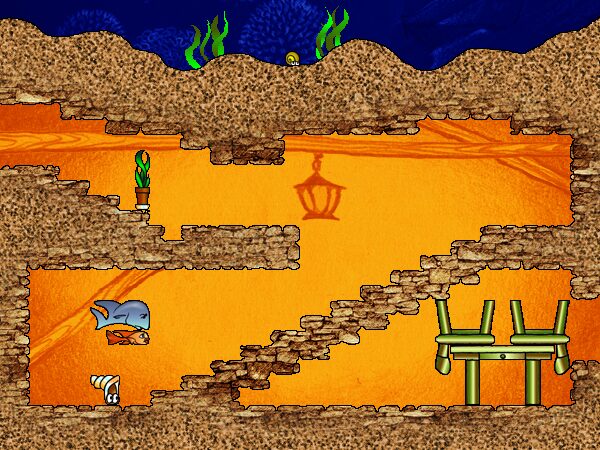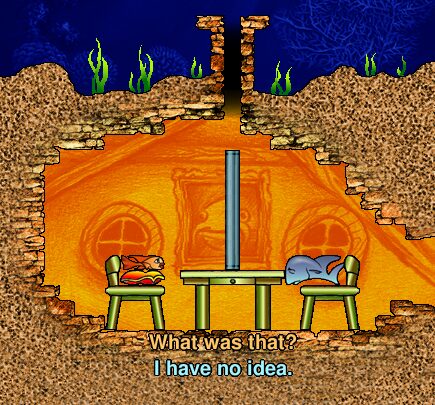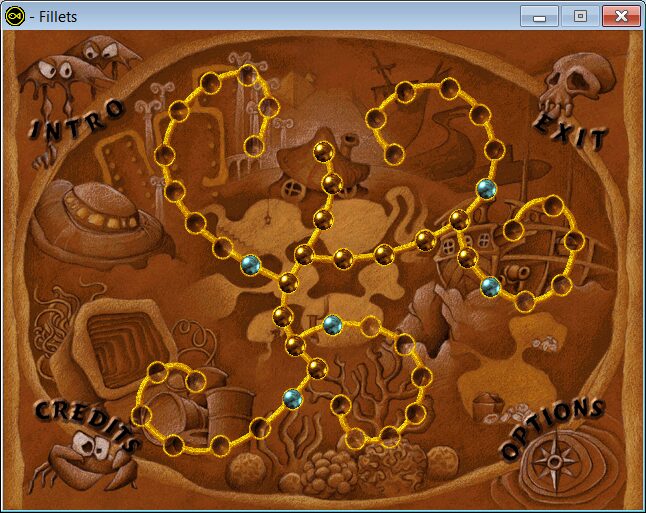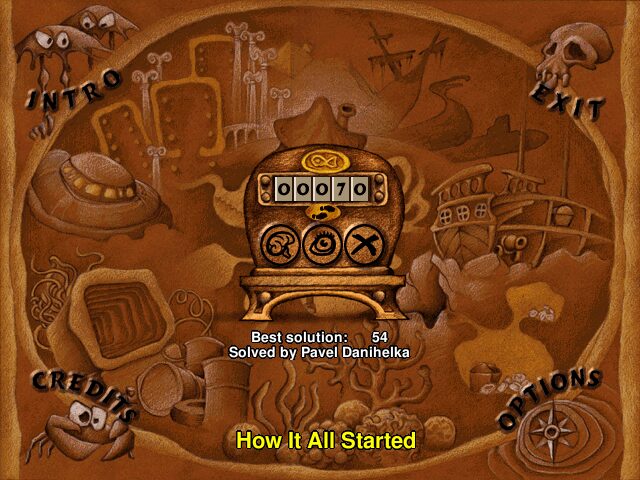Retro Replay Review
Gameplay
Fish Fillets presents a deceptively simple premise: guide two fish—a nimble small fish and a sturdy large fish—to the exit of each level by maneuvering obstacles in their path. At first glance, the mechanics of pushing and lifting objects might seem straightforward, but the game quickly reveals layers of complexity as you progress. Each object has its own weight and material properties: wooden crates slide with ease under the small fish’s paws, while steel blocks require the brute strength of the larger fish to budge them. Timing, spatial reasoning, and foresight are crucial, since a poorly placed push or a dropped object can spell instant doom for your aquatic companions.
The seventy meticulously crafted levels are grouped into eight branching paths, giving the player the freedom to tackle puzzles in a non-linear fashion once they unlock subsequent branches. This structure not only provides a sense of discovery but also caters to different playstyles—some players may prefer to master the early levels before branching out, while others will leap ahead to challenge themselves with advanced puzzles. Each branch introduces new environmental hazards and puzzle elements, such as fragile glass panels or floating platforms, ramping up the difficulty in a way that feels organic rather than punishing.
One of Fish Fillets’ standout features is the dual-character dynamic. You must constantly switch control between the two fish to coordinate complex maneuvers—drawing on the small fish’s agility to access tight spaces and the big fish’s power to move heavier obstacles. This interplay creates memorable “aha!” moments when you discover how two seemingly separate sets of abilities can combine to solve intricate spatial puzzles. It’s a design choice that not only challenges your analytical skills but also keeps the gameplay varied and engaging from start to finish.
However, Fish Fillets does not hold your hand. There is no in-game hint system, so players must rely on trial and error, pencil-and-paper sketches, or sheer mental visualization to conquer the trickiest levels. This can be both rewarding and occasionally frustrating. For those who relish cerebral challenges, this lack of guidance is a feature—it amplifies the sense of accomplishment when you finally coax both fish to safety. For more casual players, the steep learning curve might require patience and perseverance, but the payoff is well worth it.
Graphics
Though Fish Fillets debuted in the late 1990s, its hand-drawn 2D visuals retain a timeless charm. The backgrounds are painted with subtle gradients, evoking an immersive underwater environment filled with rocks, corals, and sunken debris. This atmospheric backdrop never overwhelms the foreground objects, ensuring that crates, steel blocks, and other interactive elements remain visually distinct and easy to track during fast-paced puzzle sequences.
The fish themselves are rendered with delightful personality: the small fish’s inquisitive eyes and darting fins contrast wonderfully with the large fish’s determined, lumbering expressions. Simple animations—like the gentle bob of their bodies in water or the exaggerated effort of hoisting a heavy block—lend character to otherwise static puzzle screens. Such touches reinforce the stakes of each move, making you genuinely worry when a steel beam teeters over the tiny fish’s head.
Object design follows a clear, iconographic style. Wooden crates bear visible grain textures, steel blocks have riveted edges, and fragile glass panels shimmer with transparency. This thoughtful visual language ensures you can quickly assess which obstacles require caution, which ones you can scoop up, and how your fish will interact with them. Even during the most complex setups, there’s rarely confusion about what can be moved and what must remain stationary.
Fish Fillets’ resolution may look dated on modern displays, but the game offers options to scale the viewport while preserving aspect ratio and crispness. This means you can play on large monitors without distortion or blurred sprites. The minimalist interface—lacking extraneous HUD elements—directs your full attention to the puzzle area, allowing the graphics to serve not merely as decoration but as an integral component of the gameplay experience.
Story
While Fish Fillets is first and foremost a puzzle experience, it weaves a subtle narrative through its level progression and environment design. You get the sense that the two fish are exploring the remnants of a sunken vessel or a forgotten underwater cave system. Each branch of levels feels like a new region: rocky caverns, sunlit coral gardens, and shadowy debris fields hint at a larger, untold backstory waiting beneath the waves.
The game relies on environmental storytelling rather than character-driven dialogue. The absence of text beyond minimal instructions allows players to project their own interpretations onto the fish protagonists. Are they siblings on an underwater adventure? Explorers seeking escape from an ever-shifting maze? This open-ended narrative invites curiosity and personal investment, transforming each solved puzzle into a small victory within a larger, mysterious world.
Subtle changes in background art as you advance reinforce the sense of journey. Fading sunlight filters down more dimly in deeper levels, and occasional echoes of distant sea life or collapsing rocks heighten the immersion. Though there’s no voiced narration or cutscenes, the ambiance itself becomes the storyteller, making every new branch feel like a distinct chapter in an unfolding underwater saga.
Ultimately, Fish Fillets proves that a rich, engaging story need not rely on elaborate text or cinematic flourishes. By trusting the player’s imagination and weaving narrative through level design and environmental detail, the game creates a quietly compelling world. This minimalist approach ensures that the focus remains squarely on the puzzles, but with enough thematic depth to keep exploration feeling meaningful.
Overall Experience
Fish Fillets stands out as a masterclass in puzzle design, offering deep, rewarding mechanics wrapped in a deceptively simple package. Each level feels purpose-built to teach a new concept or twist on existing rules, creating a sense of steady progression. The branching level structure adds replay value, encouraging players to revisit earlier branches with fresh perspectives gained from tackling more difficult puzzles.
The learning curve is deliberate and steep, catering to veteran puzzlers who appreciate the satisfaction of solving intellectually demanding challenges. At the same time, the game’s clear visuals and logical object properties mitigate many of the common frustrations found in physics-based puzzles. If you’re willing to embrace occasional setbacks and invest time in trial and error, Fish Fillets will reward you with genuine moments of triumph.
Despite its age, Fish Fillets remains remarkably accessible on modern systems thanks to updated ports and compatibility settings. Its minimal system requirements mean you can enjoy the game on a wide range of hardware without performance worries. Furthermore, a dedicated fan community has created level editors and challenge packs, extending the game’s lifespan well beyond its original seventy puzzles.
In summary, Fish Fillets is a timeless puzzle gem that balances thoughtful strategy, engaging mechanics, and charming presentation. Whether you’re a hardcore puzzle enthusiast or simply someone seeking a unique and brain-teasing diversion, this game delivers an experience that is simultaneously challenging, imaginative, and deeply satisfying. Prepare to dive in, pay careful attention to every move, and revel in the elegant simplicity of its design.
 Retro Replay Retro Replay gaming reviews, news, emulation, geek stuff and more!
Retro Replay Retro Replay gaming reviews, news, emulation, geek stuff and more!









Reviews
There are no reviews yet.